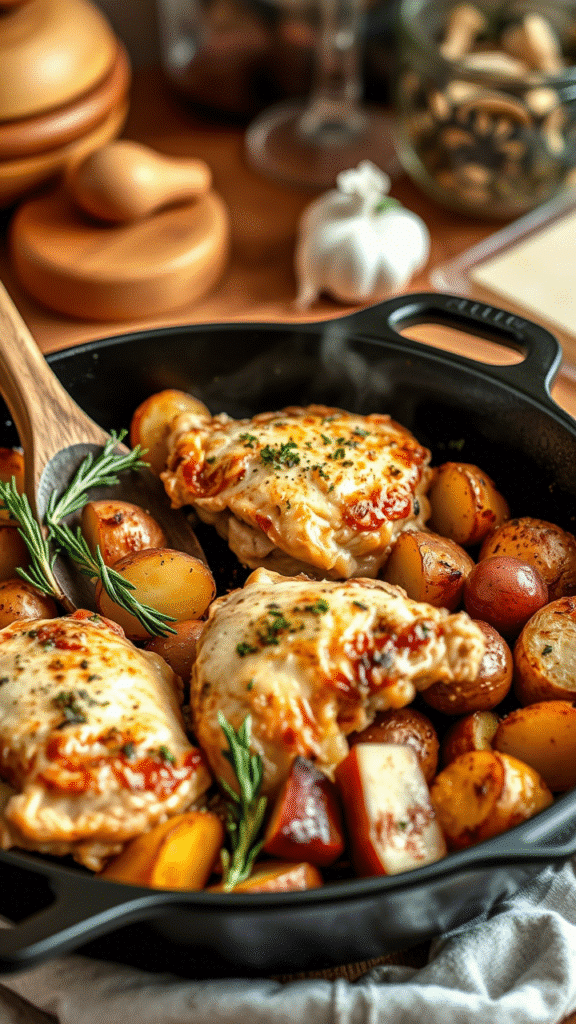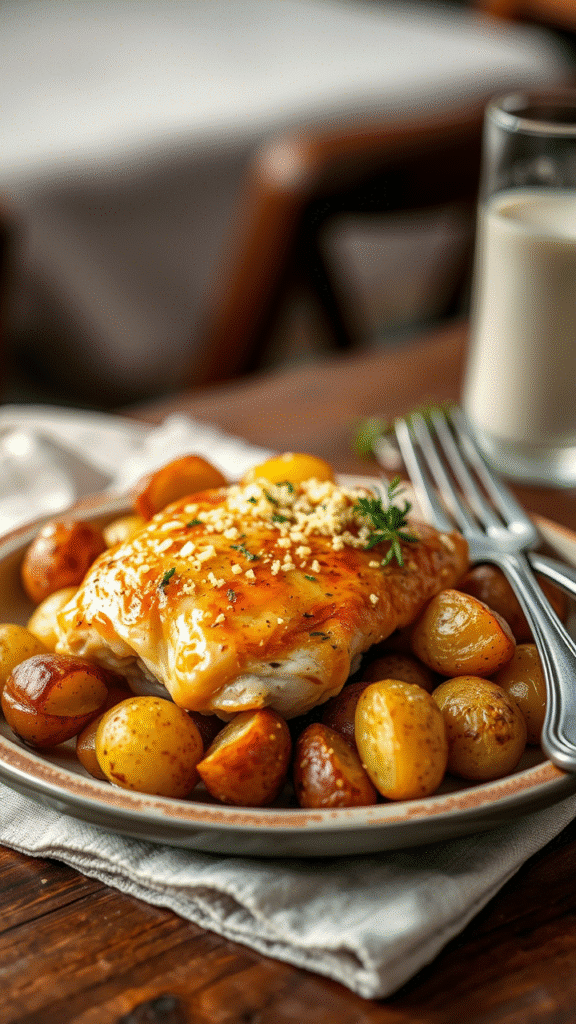The first time I witnessed a restaurant line cook prepare what seemed like twenty different dishes simultaneously, I was mesmerized by the orchestrated chaos. Yet, it wasn’t until I discovered the magic of one-pan cooking that I truly understood efficiency in the kitchen. There’s something almost therapeutic about watching golden chicken thighs sizzle alongside perfectly roasted potatoes, all while your kitchen stays relatively clean.
Garlic Parmesan Chicken and Potatoes represents the pinnacle of one-pan cooking a dish that delivers restaurant-quality flavors with minimal cleanup. This isn’t just another weeknight dinner recipe; it’s a masterclass in flavor layering and timing that transforms humble ingredients into something extraordinary.
What Makes This Recipe Special
The genius lies in the technique. By starting the potatoes first, we ensure they develop that coveted crispy exterior while maintaining a fluffy interior. The chicken renders its fat, which then bastes the potatoes below, creating layers of flavor that would be impossible to achieve in separate pans.
Most one-pan recipes suffer from compromise soggy vegetables or overcooked proteins. This recipe sidesteps those pitfalls through careful orchestration of cooking times and temperatures. The result is chicken with lacquered, caramelized skin and potatoes that rival the best steakhouse sides.
Ingredients & Substitutions
Protein:
- 6-8 bone-in, skin-on chicken thighs (about 3 pounds)
- Alternative: Chicken drumsticks or a mix of both work beautifully
Vegetables:
- 2 pounds baby potatoes, halved (or quartered if large)
- 6 cloves garlic, minced
- 1 large onion, cut into wedges
Flavor Base:
- 1 cup freshly grated Parmesan cheese
- 3 tablespoons olive oil
- 2 tablespoons butter, melted
- 2 teaspoons dried Italian seasoning
- 1 teaspoon paprika
- 1 teaspoon garlic powder
- Salt and freshly cracked black pepper
Fresh Elements:
- 2 tablespoons fresh parsley, chopped
- 1 lemon, cut into wedges
Professional Substitution Notes
Baby potatoes are non-negotiable for texture, but if unavailable, use Yukon Golds cut into 2-inch pieces. Russets will work in a pinch, though they’ll be less creamy. The starch content matters here you want potatoes that hold their shape while developing that golden crust.
For the Parmesan, invest in a good wedge and grate it yourself. Pre-grated cheese contains anti-caking agents that prevent proper melting and browning. Pecorino Romano can substitute, but use sparingly it’s saltier and more assertive.
Chicken thighs are essential for this recipe’s success. Breasts will overcook and dry out during the extended roasting time. If you must use breasts, reduce cooking time by 10-15 minutes and check internal temperature frequently.
Step-by-Step Instructions

Preparation Phase
Preheat your oven to 425°F (220°C). This high heat is crucial for achieving proper browning on both the chicken and potatoes. Position your rack in the lower third of the oven to promote bottom browning of the potatoes.
Pat chicken thighs completely dry with paper towels this step is critical for crispy skin. Season generously with salt and pepper at least 30 minutes before cooking. Room temperature chicken cooks more evenly than cold chicken straight from the refrigerator.
The Foundation: Potatoes First
In a large roasting pan or cast-iron skillet, toss halved potatoes with 2 tablespoons olive oil, salt, and pepper. Arrange cut-side down in a single layer. This positioning is crucial the flat surface creates maximum contact with the hot pan, promoting browning.
Roast potatoes alone for 15 minutes. This head start ensures they’ll be tender when the chicken finishes cooking. Many home cooks skip this step and wonder why their potatoes remain hard and pale.
Building the Garlic Parmesan Crust
While potatoes roast, combine grated Parmesan, melted butter, minced garlic, Italian seasoning, paprika, and garlic powder in a bowl. The mixture should resemble wet sand. This paste will form the golden crust that makes this dish special.
The Main Event: Adding Chicken
Remove the pan from the oven and nestle chicken thighs skin-side up among the potatoes. Don’t overlap air circulation is essential for crispy skin. Brush chicken with remaining olive oil, then pat the Parmesan mixture evenly over each thigh.
Scatter onion wedges around the pan, tucking them between chicken and potatoes. They’ll caramelize beautifully in the rendered chicken fat.
Final Roasting
Return to oven and roast for 35-40 minutes, until chicken reaches 175°F (79°C) in the thickest part. The higher temperature for dark meat ensures the collagen breaks down properly, resulting in tender, juicy meat.
Resist the urge to move anything during cooking. Each piece needs to develop its crust undisturbed. If the Parmesan topping browns too quickly, tent loosely with foil.
Cooking Techniques & Science
The Maillard reaction is your best friend in this recipe. By starting with dry chicken and high heat, we encourage the proteins and sugars to brown, creating complex flavors impossible to achieve through other methods. The rendered chicken fat becomes liquid gold, basting the potatoes and creating unified flavors throughout the dish.

Temperature control separates amateur from professional results. 425°F strikes the perfect balance hot enough for browning, gentle enough to cook through without burning the delicate Parmesan crust. Lower temperatures won’t achieve proper browning; higher temps risk burning before the interior cooks.
The bone-in thighs act as natural thermometers and flavor enhancers. Bones conduct heat differently than muscle, helping maintain moisture while adding depth through their marrow. Skin-on thighs provide both protection and texture that crispy skin is pure culinary gold.
Tool Impact
A heavy-bottomed roasting pan or cast-iron skillet distributes heat evenly, preventing hot spots that can burn the delicate Parmesan crust. Thin pans cause uneven browning and potential burning. If using a lighter pan, reduce temperature by 25°F and extend cooking time slightly.
Serving & Pairing Suggestions
Present this dish family-style in the cooking vessel the rustic presentation adds to its charm. Garnish with fresh parsley and lemon wedges just before serving. The bright acidity cuts through the rich, savory flavors beautifully.

This hearty dish pairs wonderfully with simple sides that won’t compete for attention. A crisp arugula salad with lemon vinaigrette provides textural contrast and palate-cleansing properties. Roasted asparagus or green beans work well, though avoid anything that requires oven space.
Wine Pairing
The rich, savory flavors call for medium-bodied wines. A Chardonnay with light oak complements the Parmesan, while a Pinot Noir’s acidity balances the richness. For budget-friendly options, a Côtes du Rhône blanc or a Spanish Tempranillo work beautifully.
Leftover Magic
Leftover chicken and potatoes transform into incredible hash. Chop everything roughly, sauté in a hot skillet until crispy, and top with fried eggs. The concentrated flavors actually improve overnight.
Conclusion
Garlic Parmesan Chicken and Potatoes proves that sophisticated flavors don’t require complicated techniques. By understanding the science behind browning and timing, we create a restaurant-quality meal with minimal effort and cleanup.
The key lies in patience—letting each component develop its character before combining them. Those fifteen minutes of potato pre-roasting and the careful application of the Parmesan crust separate this from ordinary one-pan meals.
Master this recipe, and you’ve mastered the principles of successful one-pan cooking: proper timing, temperature control, and flavor layering. These skills translate to countless other dishes, making you a more confident and capable cook.
Final Expert Tips
Always use a meat thermometer guessing doneness leads to disappointment. Let the dish rest for 5 minutes after cooking; this allows juices to redistribute and prevents the chicken from appearing dry when carved.
For extra flavor depth, add a splash of white wine to the pan during the last 10 minutes of cooking. The alcohol evaporates, leaving behind concentrated flavor that enhances both chicken and potatoes.
Don’t be afraid to experiment with the herb blend. Rosemary and thyme work beautifully, though dried herbs should be added earlier in the process to bloom properly. Fresh herbs should be added at the very end to preserve their bright flavors.
Frequently Asked Questions?
Q: Can I use boneless chicken thighs instead of bone-in?
A: While possible, boneless thighs cook faster and don’t provide the same depth of flavor. If using boneless, reduce cooking time by 10-15 minutes and check temperature frequently. The bones add significant flavor and help prevent overcooking.
Q: My Parmesan crust burned before the chicken was done. What went wrong?
A: This usually indicates either too high temperature or positioning too close to the heating element. Try reducing temperature to 400°F and moving the rack to the center position. You can also tent with foil if browning too quickly.
Q: Can I prep this dish ahead of time?
A: You can season the chicken and prepare the Parmesan mixture up to 24 hours ahead. However, don’t combine them until ready to cook, as the salt will draw moisture from the cheese. Potatoes can be cut and stored in cold water to prevent browning.
Q: What if my potatoes aren’t crispy enough?
A: Ensure potatoes are cut-side down and not overcrowded. Increase the initial roasting time to 20 minutes if needed. Some potato varieties have higher moisture content and need more time to develop proper browning.
Q: Can I double this recipe for a larger crowd?
A: Use two pans rather than crowding everything into one large pan. Overcrowding prevents proper browning and creates steam instead of the desired crispy textures. Cook both pans simultaneously on different racks, rotating positions halfway through for even cooking.

Veronica is a passionate food enthusiast with over three years of experience in exploring and writing about diverse cuisines. Her expertise lies in reviewing restaurants, sharing creative recipes, and discovering the latest food trends. As the voice behind FoodieRecap.com, Anju brings fresh perspectives and culinary insights to her audience.
